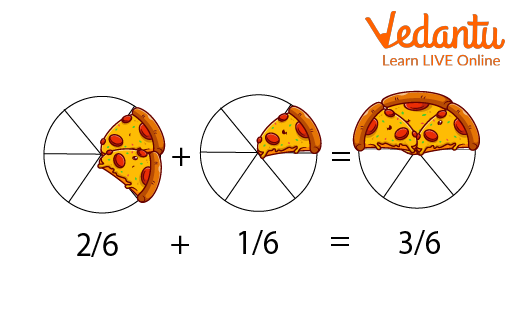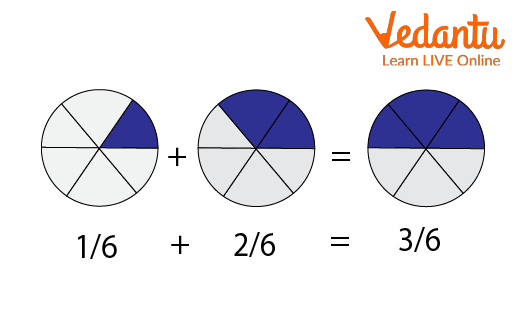




What is a Fraction?
A fraction is defined as a part of the whole. We do addition and subtraction of fractions in our daily life also. Let us understand it with the help of an example.
Riya orders a pizza. When the pizza arrived, Riya saw that the pizza was divided into six equal pieces. She decided to eat two pieces of pizza for lunch and store the rest. After a few hours, she decided to eat one more piece of pizza. Can you tell how many pieces of Pizza she ate? Yes, you are right. She ate three pieces of pizza out of 6 six pieces which mean she ate half of the pizza.

Addition of Fraction Shown by Adding Pieces of Pizza.
Addition and Subtraction of Fractions
All fractions are not added or subtracted in the same way. There are different ways to add or subtract different types of fractions depending on certain conditions.
Condition 1. When fractions have the same denominator
Condition 2. When fractions have different denominators
Addition or Subtraction of Fractions with the Same Denominator
Fractions with the same denominators are called fractions, and adding and subtracting them is very easy.
Example 1: $\dfrac{1}{5} + \dfrac{2}{5}$= ?
The above example is an example of like fractions because the denominator is the same.
In such cases, all you have to do is to focus on numerators and add the numerator.
1+2 = 3
Therefore, $\dfrac{1}{5} + \dfrac{2}{5}$= $\dfrac{3}{5}$

Addition of Like Terms.
You have to follow the same method with subtraction also.
Example 2: $\dfrac{5}{7} - \dfrac{2}{7}$ =?
we know that these are like Fractions and
5-2= 3
Therefore $\dfrac{5}{7} - \dfrac{2}{7}$= $\dfrac{3}{7}$
Addition or Subtraction of Fractions with Different Denominators
We have to add a subscription to the fractions with different denominators. The first that we have to do is convert unlike fractions into like fractions.
For converting fractions into like fractions, we have to do the following steps.
Example 1: $\dfrac{27}{4} + \dfrac{29}{8}$ = ?
To convert the Unlike fraction into a like fraction, we must take out the LCM of the denominators.
In this case, the LCM of 4 and 8 is 8.
The next step is to divide the denominator of the fraction with LCM.
For $\dfrac{27}{4}$ ,
$\dfrac{8}{4}$= 2
Multiply the resulting number with the numerator and denominator of the fraction
$\dfrac{27}{4} \times \dfrac{2}{2}$ = $\dfrac{54}{8}$
Repeat the process with the other fraction
For $\dfrac{29}{8}$
$\dfrac{8}{8} = 1$
Multiplying numerator and denominator with the given number
$\dfrac{29}{8} \times \dfrac{1}{1}$ = $\dfrac{29}{8}$
Now since both the numbers are converted into like fractions
$\dfrac{27}{4}$ becomes $\dfrac{54}{8}$
$\dfrac{29}{8}$ remains $\dfrac{29}{8}$
On adding these $\dfrac{54}{8} + \dfrac{29}{8} = \dfrac{83}{8}$
Therefore $\dfrac{27}{4} + \dfrac{29}{8} = \dfrac{83}{8}$
Let us understand one example of subtraction with unlike fractions also.
Example 2: $\dfrac{3}{4} - \dfrac{1}{6}$ = ?
The first step to converting unlike fractions into like fractions is to take the LCM of the denominator.
In this case, the LCM of 4 and 6 is 12.
The next step is to divide the denominator of the fraction with the LCM.
For $\dfrac{3}{4}= \dfrac{12}{4} = 3$
Multiply the resulting number with the numerator and denominator of the fraction so $\dfrac{3}{4} \times \dfrac{3}{3} = \dfrac{9}{12}$
Complete this step with attraction also.
For $\dfrac{1}{6}= \dfrac{12}{6} = 2$
Now, $\dfrac{1}{6} \times \dfrac{2}{2} = \dfrac{2}{12}$
Therefore,
$\dfrac{3}{4}$ becomes $\dfrac{9}{12}$
$\dfrac{1}{6}$ becomes $\dfrac{2}{12}$
Subtract like fractions.
$\dfrac{9}{12} - \dfrac{2}{12} = \dfrac{7}{12}$
Therefore, $\dfrac{3}{4} - \dfrac{1}{6} = \dfrac{7}{12}$
Practice Questions
1. $\dfrac{15}{83} + \dfrac{20}{83}$
Ans: $\dfrac{35}{83}$
2. $\dfrac{7}{8} + \dfrac{3}{4}$
Ans: $\dfrac{13}{8}$
3. $\dfrac{2}{8} + \dfrac{2}{4}$
Ans: $\dfrac{3}{4}$
4. $\dfrac{7}{9} - \dfrac{11}{45}$
Ans: $\dfrac{8}{15}$
5. $\dfrac{1}{11} + \dfrac{2}{12}$
Ans: $\dfrac{17}{66}$
Summary
Fractions are part of a whole, and adding or subtracting fractions is something we use in everyday life. Fractions are added or subtracted in different ways depending if they are like fractions or unlike fractions.
Like fractions are those fractions that have the same denominator, and unlike fractions are those fractions that have different denominators. We will get to know what fractions are, the different types of fractions, how to subtract a fraction, etc. There are a few solved examples that will help you to understand the concept of fractions better. fraction subtraction examples are also there.
FAQs on Addition and Subtraction of Fraction
1. What is some daily life example of the addition of fractions?
We use the addition of fractions in our daily life, and some of the examples are as follows:
Example 1. Suppose you ate 1 and $\dfrac{1}{2}$ roti for lunch and 1 and $\dfrac{1}{2}$ roti for dinner.
Total number of rotis that you ate is 1+1 = 2 and $\dfrac{1}{2}$ + $\dfrac{1}{2}$ = 1
Therefore you ate 3 rotis in total.
Example 2. Suppose you studied 3 and 1/2 hours in your tuition classes and $\dfrac{1}{2}$ hour at night.
So the total number of hours you studied will be 3 and $\dfrac{1}{2}$ + $\dfrac{1}{2}$ = 1
Therefore, 3+1 = 4 hours.
2. What are the rules of subtracting in unlike fractions?
he main thing we need to understand before subtracting unlike fractions is that we have to convert the unlike fractions into like fractions.
Unlike fractions can be converted into like fractions by taking out the LCM of the denominator, dividing denominator refraction by the LCM, and multiplying the resulting number by the numerator and denominator of the same fraction.
3. Why do we need to add or subtract fractions?
We already know that fractions are part of a whole. They represent parts of the total that must be of the same size. The addition or subtraction of fractions gives us a peek into algebra which is important for higher studies. The addition and subtraction of fractions help us to understand Maths in detail and are also required in many jobs to solve daily life practical problems. For example- currency is divided into fractions.











